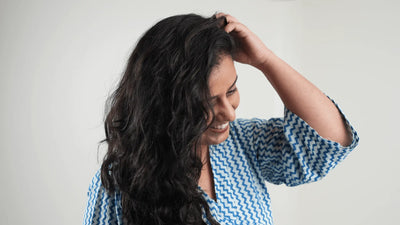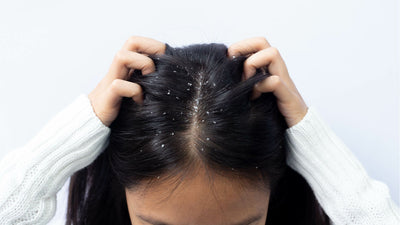Insight: Men in their late 30s and 40s face hormone-driven hair and skin changes, thinning, slower growth cycles, dryness, greying, collagen decline, and pigmentation. Studies show these shifts are tied to DHT sensitivity, reduced sebum, and cumulative sun damage.
So? We aim to break down the whys and hows of the science behind these hormone-driven changes in a bite-sized and structured manner for the consumer, where we divide skin and hair into 2 separate blogs.
Why Does Men's Hair Change in Their Late 30s and Early 40s? Let's Break it Down!
Let’s be honest. Age can catch up with you. Somewhere between hectic work schedules, late-night deadlines, and a slowing metabolism, many men start noticing subtle (and sometimes not-so-subtle) changes in their hair.
Increased strands on the pillows and in the shower, a hint of grey in their beards and on their temples or a slowly receding hairline.
The best way to respond to these changes is through science.
Our research has identified four major hair-related concerns that most men in India experience during this phase of life.
1. Thinning & hair loss
This is the most common change men notice. Male pattern baldness occurs when hair follicles at the temples and crown are more sensitive to DHT, a hormone derived from testosterone. The back and sides of the head are less sensitive. Because of this increased sensitivity, DHT binds to receptors in these follicles, causing them to shrink, shorten their growth phase, and produce thinner hairs.
As follicles age, their ability to regenerate weakens due to the depletion and dysfunction of the stem cells that are responsible for regeneration. The cells slowly become inactive and divide less, making them more vulnerable to DHT’s effects. Over time, this leads to temple recession and crown thinning seen in androgenetic alopecia.
But by incorporating a 3% Redensyl and 3% Procapil-powered Intensive Hair Growth Serum into your routine, you can work to reduce these signs. Redensyl acts on hair follicle stem cells and dermal papilla cells to promote growth signals. Procapil blocks DHT activity, specifically through oleanolic acid, which can inhibit 5α-reductase, the enzyme that converts testosterone to DHT.
Unhealthy habits like stress, poor diet, smoking, and not getting enough sleep can also make hair thinning worse. Eating healthy foods with protein, iron, zinc, and biotin, and managing stress can also help slow down hair loss.
2. Slower hair growth cycles
Your hair’s natural growth cycle changes with age. The anagen (growth) phase shortens because as we age, the cells that control hair growth and the tiny blood vessels that supply nutrients to the scalp become less active. This weakens the signals that keep hair in the anagen (growth) phase, causing it to shorten over time.
The telogen (shedding) phase lengthens because the biological signals that trigger new growth weaken. Thehair follicle stem cells and dermal papilla cells become less responsive, so it takes longer for a new hair to re-enter the anagen (growth) phase after shedding.
Physical and emotional stress can push hair follicles into an early telogen phase, leading to noticeable hair shedding. Similarly, deficiencies in nutrients like iron, protein, and vitamin D cause hair to cycle irregularly between the resting and shedding phases. This leads to increased hair loss. Both stress and nutritional gaps disrupt the normal hair growth cycle. As a result, more hair falls.
Additionally, reduced scalp blood flow and hormonal changes can slow follicle metabolism, extending the telogen (resting) phase before new growth begins. This doesn’t always lead to noticeable hair loss, but it can make your hair appear thinner and less voluminous over time. The good news is that with consistency and the right routine, you can support healthier growth. Using products that contain anti-hair loss actives such as Redensyl and Hairdian AP can help reactivate dormant follicles, shorten the telogen phase, and minimise follicle shrinkage. This creates the optimal scalp environment for healthy hair growth.
3. Changes in hair texture
In your 30s and 40s, your hair can feel drier, rougher or more brittle. It’s often because your scalp produces less sebum (the natural oil that keeps hair smooth and protected). Without enough sebum, the cuticle (the outer protective layer) can lift or crack, and the cortex loses moisture, making hair stiff, frizzy, and prone to breakage. External factors, such as sun exposure, friction from pillows, hard water, or frequent heat styling, can exacerbate these textural changes.
To restore softness and strength, use haircare products that cleanse without stripping oils and nourish with targeted actives. Ingredients like plant protein can strengthen hair from within, vegan keratin helps repair cuticle damage, and hyaluronic acid or glycerin helps attract and retain moisture within the hair shaft. Routine adjustments also help reduce shampoo frequency to preserve natural oils, incorporate a nourishing oil or serum, and use a deep hydration mask once or twice a week to keep hair resilient and smooth.
4. Greying
By your late 30s or early 40s, the activity of melanocytes, the cells responsible for producing your hair’s natural pigment, begins to slow down because they enter a state called senescence (ageing at the cellular level). This happens due to damage from factors like oxidative stress, DNA damage, and changes in their metabolism, which impair their ability to produce pigment. This entire process causes grey hairs to become more noticeable. Contrary to popular belief, this greying is not caused by chemical sprays, hair bleach, creams, or plucking individual grey hairs.
Greying is a natural and inevitable part of ageing. To help slow down the process and support natural pigmentation, consider using scalp treatments infused with active ingredients like Arcolys®. This ingredient boosts melanin synthesis by stimulating tyrosinase, an essential enzyme for pigment production. Other actives like Silverfree™ activate specific genes such as CREB, MITF, and TYRP1, which are involved in hair pigmentation. MelanoGray™ enhances the production of eumelanin, the pigment responsible for darker hair. These ingredients have been clinically shown to reduce pigment loss and promote a more even hair tone over time. Greying is not wrong; it is a natural biological process. So yes, while using our anti-grey serum can increase melanin production, if you choose to embrace your greys, there is absolutely nothing wrong with that.
5. Strengthening your hair from the inside out
Healthy hair and skin start deeper than what you apply. Nutrition plays a huge role. Physical and emotional stress, and nutritional deficiencies can cause the hair follicles to enter an early telogen phase, resulting in a noticeable amount of shedding. Supplements rich in biotin and omega-3 fatty acids can support stronger strands, healthier skin, and long-term vitality.
Tying it all together
Ageing is not a decline, it’s a transition. Your body is evolving and so should your haircare routine.
At Arata, our mission is to combine empathy with evidence, helping you understand the “why” behind every change, and empowering you with proven, science-backed solutions that work with your biology, not against it.
















